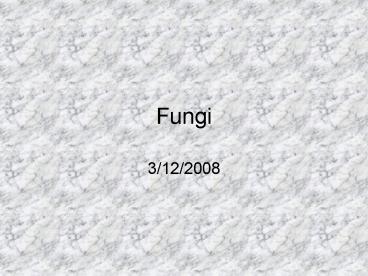Fungi - PowerPoint PPT Presentation
1 / 18
Title:
Fungi
Description:
rhizoid. stolon. basidium. saprobe. lichen. mycorrhiza. Definition ... Rhizoid: rootlike hyphae that penetrate surface of bread. ... – PowerPoint PPT presentation
Number of Views:494
Avg rating:3.0/5.0
Title: Fungi
1
Fungi
- 3/12/2008
2
Essential Questions for Fungi
- What is a Fun Gi?
3
Vocabulary
- fruiting body
- sporangium
- ascus
- chitin
- hypha
- mycelium
- rhizoid
- stolon
- basidium
- saprobe
- lichen
- mycorrhiza
4
Definition
- Eukaryotic heterotrophs that have cell walls made
of chitin. (Same chemical that is found in
insects) - Dont ingest!
- They digest food outside their body then absorb
it! - Some are parasites.
5
Characteristics
- Type of cell Eukaryotic
- Number of cells Multi-cellular except yeasts
- Habitat Damp warm places
- Structure
- Composed of filaments called hyphae
- Fruiting body is a reproductive structure
- Mycelium is a tangled mass of hyphae
- Absorbs food
- Makes up body
6
Branching Out
- How are fungi spread?
- Spores must land in a favorable environment.
- Reproduction
- Asexual hyphae break off from a fungus begin
to grow on their own and/or produce spores. - Sexual Labeled as () or (-), reproduction
occurs when hyphae of opposite mating types meet.
7
Classification
- Classification Based on structure and method of
reproduction - Common molds
- Phylum Zygomycota
- Grow on meat, cheese, and bread
- Black bread mold Rhizopus stolonifer
- Stolons stemlike hyphae on surface of bread
- Rhizoid rootlike hyphae that penetrate surface
of bread. Anchor, release enzymes absorb
digested matter.
8
Sac Fungi
- Phylum Ascomycota
- Have an ascus, which produces the spore, 2
different kinds of spore are produced depending
on conditions - Largest phylum with 30,000 species
- Includes yeast (unicellular) which reproduces by
budding - Bread rises b/c yeast produces carbon dioxide
9
Club Fungi
- Phylum Basidiomycota
- Diverse phyla
- Mushrooms are in these phyla
- Have gills, cap, stalk, and base
- Also includes shelf fungi puff balls
- Growth is due to cell enlargement not cell
division - Mushrooms produce billions of spores, while
puffballs produce trillions - They are present in the ground and push above
when conditions are right (moisture is the biggie)
10
Club fungus drawing
11
Imperfect Fungi
- Phylum Deuteromycota (dont appear to have sexual
reproduction) - Cannot be placed in any other phylum because
their type of reproduction cannot be determined - Examples include Bleu cheese (Penicillium mold)
and Aspergillus (soy sauce)
12
Lichens/Mycorrizae
- Mycorrizae have a mutualistic relationship with
plants (aid in absorbing water nutrients),
while plants provide fungi with products of
photosynthesis - Lichens have a symbiotic relationship between a
photosynthetic organism a fungus (sac or club) - Fungus provides protection and water
- Algae or bacteria provide food
13
14
15
16
17
18
Other tidbits
- Fungi are found in every ecosystem
- Some parasitic fungi cause animal plant
diseases (corn smut, mildew, wheat rust,
ringworm, athletes foot, yeast infections, and
thrush)































